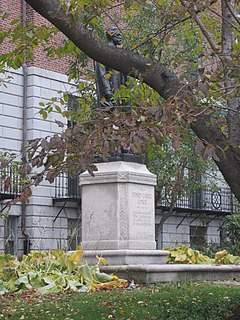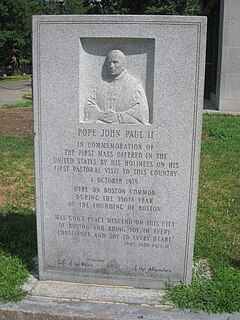
Theo Alice Ruggles Kitson, also known as Tho. A. R. Kitson and Theo Alice Ruggles, was an American sculptor.

Nuns of the Battlefield is a public artwork made in 1924 by Irish artist Jerome Connor, located at the intersection of Rhode Island Avenue NW, M Street, and Connecticut Avenue NW, in Washington, D.C., United States. A tribute to the more than 600 nuns who nursed soldiers of both armies during the American Civil War, it is one of two monuments in the District that mark women's roles in the conflict. It is a contributing monument to the Civil War Monuments in Washington, D.C., listed on the National Register of Historic Places. In 1993, it was surveyed for the Smithsonian Institution's Save Outdoor Sculpture! program.

Jerome Connor was an Irish sculptor.

The Lapham Memorial is a public artwork by American artist Albert H. Atkins, located near the entrance to Lapham Hall, on the University of Wisconsin–Milwaukee campus. It is in memory of Increase A. Lapham, a 19th-century scientist famous for prompting the creation of the National Weather Service and recording the antiquities of Wisconsin, among other accomplishments.

The Boston Massacre Monument, also known as the Crispus Attucks Monument and Victory, is an outdoor bronze memorial by Adolph Robert Kraus, installed in Boston Common, in Boston, Massachusetts, United States.

A statue of Horace Mann by Emma Stebbins is installed outside the Massachusetts State House, in Boston, Massachusetts, United States.

A statue of Henry Cabot Lodge by Raymond Averill Porter is installed outside the Massachusetts State House, in Boston, Massachusetts, United States.

The Charlestown Civil War Memorial, also known as the Soldiers' and Sailors' Monument, is an outdoor granite monument and sculpture by Martin Milmore, commemorating the men of Charlestown, Boston, who fought to preserve the Union during the American Civil War. The memorial is installed in the Training Field in Charlestown, in the U.S. state of Massachusetts.

Declaration of Independence Tablet is a 1925 sculpture by John Francis Paramino, installed at Boston Common, in Boston, Massachusetts, United States.

An equestrian statue of George Washington by Thomas Ball is installed in Boston's Public Garden, in the U.S. state of Massachusetts.
The Massachusetts Korean War Memorial is installed in Charlestown, Boston's Charlestown Naval Shipyard Park, within the Boston Navy Yard, in the U.S. state of Massachusetts. The 1993 memorial was commissioned by the Massachusetts Korean War Veterans Committee. It features a bronze sculpture of a soldier on a granite base. The memorial was surveyed by the Smithsonian Institution's "Save Outdoor Sculpture!" program in 1997.

A statue of David I. Walsh by Joseph Coletti is installed along Boston's Charles River Esplanade, in the U.S. state of Massachusetts.

The Hungarian Revolution Memorial is a monument and sculpture by E. Gyuri Hollosy, installed in Boston's Liberty Square Park, in the U.S. state of Massachusetts. It commemorates the thirtieth anniversary of the Hungarian Revolution of 1956.
John Barry Tablet is a tablet with a portrait bust in relief of naval officer John Barry by John Francis Paramino, installed in Boston Common in Boston, Massachusetts, United States.

A memorial placard of Pope John Paul II, sometimes called Papal Mass Plaque, is installed in Boston Common in Boston, Massachusetts, United States.

A statue of American Revolutionary War hero William Prescott by William Wetmore Story is installed next to the Bunker Hill Monument in Charlestown, Boston, Massachusetts, United States.

The Oneida Football Club Monument, sometimes called Football Tablet, is a monument by Joseph Coletti, installed in Boston Commons, in Boston, Massachusetts, United States.

General Israel Putnam is a monumental statue in Hartford, Connecticut, United States. Located in the city's Bushnell Park, the statue was designed by sculptor John Quincy Adams Ward and honors Israel Putnam, a military officer in the Continental Army during the American Revolutionary War. The statue was largely paid for by a donation from judge Joseph P. Allyn and was dedicated in a large ceremony in 1874. It was one of the first statues to be erected in the park, which nowadays houses several other monuments to famous Connecticut residents. From an artistic standpoint, the statue has received mixed reviews from critics.

Major General Ambrose E. Burnside, also known as the Ambrose Burnside Monument, is a monumental equestrian statue in Providence, Rhode Island, United States. The statue, located in the city's Burnside Park, was designed by sculptor Launt Thompson and depicts Ambrose Burnside, an officer in the Union Army during the American Civil War who later served as the governor of Rhode Island. Ambrose had died in 1881 and the project to erect a statue in his honor began shortly afterwards. It was dedicated on July 4, 1887 in a large ceremony that included several notable guests of honor, such as General William Tecumseh Sherman, Colonel Robert Hale Ives Goddard, and the governors of both Connecticut and Rhode Island. The monument was originally located in Exchange Place, but it was moved to its current location in the early 1900s. As part of the move, the pedestal was replaced with one designed by William R. Walker.

















